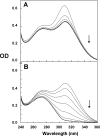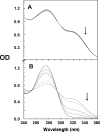Kinetic characterization of the inhibition of protein tyrosine phosphatase-1B by Vanadyl (VO2+) chelates
- PMID: 29071441
- PMCID: PMC5671894
- DOI: 10.1007/s00775-017-1500-1
Kinetic characterization of the inhibition of protein tyrosine phosphatase-1B by Vanadyl (VO2+) chelates
Abstract
Protein tyrosine phosphatases (PTPases) are a prominent focus of drug design studies because of their roles in homeostasis and disorders of metabolism. These studies have met with little success because (1) virtually all inhibitors hitherto exhibit only competitive behavior and (2) a consensus sequence H/V-C-X5-R-S/T characterizes the active sites of PTPases, leading to low specificity of active site directed inhibitors. With protein tyrosine phosphatase-1B (PTP1B) identifed as the target enzyme of the vanadyl (VO2+) chelate bis(acetylacetonato)oxidovanadium(IV) [VO(acac)2] in 3T3-L1 adipocytes [Ou et al. J Biol Inorg Chem 10: 874-886, 2005], we compared the inhibition of PTP1B by VO(acac)2 with other VO2+-chelates, namely, bis(2-ethyl-maltolato)oxidovanadium(IV) [VO(Et-malto)2] and bis(3-hydroxy-2-methyl-4(1H)pyridinonato)oxidovanadium(IV) [VO(mpp)2] under steady-state conditions, using the soluble portion of the recombinant human enzyme (residues 1-321). Our results differed from those of previous investigations because we compared inhibition in the presence of the nonspecific substrate p-nitrophenylphosphate and the phosphotyrosine-containing undecapeptide DADEpYLIPQQG mimicking residues 988-998 of the epidermal growth factor receptor, a relevant, natural substrate. While VO(Et-malto)2 acts only as a noncompetitive inhibitor in the presence of either subtrate, VO(acac)2 exhibits classical uncompetitive inhibition in the presence of DADEpYLIPQQG but only apparent competitive inhibition with p-nitrophenylphosphate as substrate. Because uncompetitive inhibitors are more potent pharmacologically than competitive inhibitors, structural characterization of the site of uncompetitive binding of VO(acac)2 may provide a new direction for design of inhibitors for therapeutic purposes. Our results suggest also that the true behavior of other inhibitors may have been masked when assayed with only p-nitrophenylphosphate as substrate.
Keywords: Bis(acetylacetonato)oxidovanadium(IV); Protein tyrosine phosphatase-1B; Steady-state kinetics; Uncompetitive inhibition; VO(acac)2; Vanadyl (VO2+) chelates.
Figures








Similar articles
-
The vanadyl (VO2+) chelate bis(acetylacetonato)oxovanadium(IV) potentiates tyrosine phosphorylation of the insulin receptor.J Biol Inorg Chem. 2005 Dec;10(8):874-86. doi: 10.1007/s00775-005-0037-x. Epub 2005 Oct 19. J Biol Inorg Chem. 2005. PMID: 16235045
-
Synthesis and evaluation of oxovanadium(IV) complexes of Schiff-base condensates from 5-substituted-2-hydroxybenzaldehyde and 2-substituted-benzenamine as selective inhibitors of protein tyrosine phosphatase 1B.Dalton Trans. 2012 Aug 28;41(36):11116-24. doi: 10.1039/c2dt30198a. Dalton Trans. 2012. PMID: 22864521
-
The Structural Basis of Action of Vanadyl (VO2+) Chelates in Cells.Coord Chem Rev. 2014 Nov 1;279:1-22. doi: 10.1016/j.ccr.2014.07.003. Coord Chem Rev. 2014. PMID: 25237207 Free PMC article.
-
PTP1b Inhibition, A Promising Approach for the Treatment of Diabetes Type II.Curr Top Med Chem. 2019;19(4):246-263. doi: 10.2174/1568026619666190201152153. Curr Top Med Chem. 2019. PMID: 30714526 Review.
-
Potential Inhibitors of Protein Tyrosine Phosphatase (PTP1B) Enzyme: Promising Target for Type-II Diabetes Mellitus.Curr Top Med Chem. 2020;20(29):2692-2707. doi: 10.2174/1568026620999200904121432. Curr Top Med Chem. 2020. PMID: 32888269 Review.
Cited by
-
Vanadium in Biological Action: Chemical, Pharmacological Aspects, and Metabolic Implications in Diabetes Mellitus.Biol Trace Elem Res. 2019 Mar;188(1):68-98. doi: 10.1007/s12011-018-1540-6. Epub 2018 Oct 22. Biol Trace Elem Res. 2019. PMID: 30350272 Free PMC article. Review.
-
Efficient Synthesis and HPLC-Based Characterization for Developing Vanadium-48-Labeled Vanadyl Acetylacetonate as a Novel Cancer Radiotracer for PET Imaging.Molecules. 2024 Feb 9;29(4):799. doi: 10.3390/molecules29040799. Molecules. 2024. PMID: 38398551 Free PMC article.
References
-
- Tonks NK, Diltz CD, Fischer EH. J Biol Chem. 1988;263:6731–67372. - PubMed
-
- Tonks NK, Diltz CD, Fischer EH. J Biol Chem. 1988;263:6722–6730. - PubMed
-
- Sarmiento M, Zhao Y, Gordon SJ, Zhang ZY. J Biol Chem. 1998;273:26368–2637. - PubMed
-
- Zhang S, Zhang ZY. Drug Discovery Today. 2007;12:373–381. - PubMed
MeSH terms
Substances
Grants and funding
LinkOut - more resources
Full Text Sources
Other Literature Sources
Research Materials
Miscellaneous

